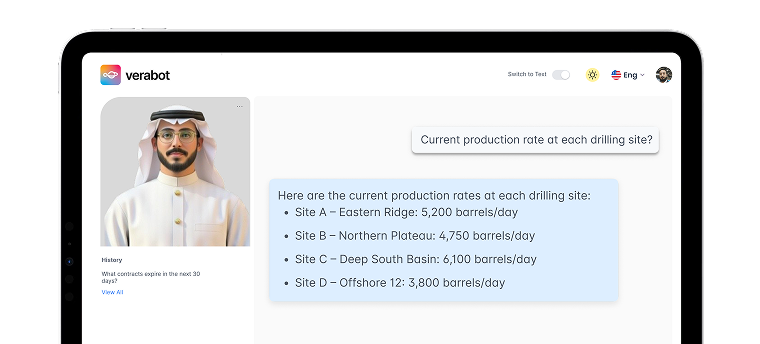Oil & Gas Technology Solutions
Toward a Safer, Smarter, and Cleaner Oil and Gas Industry
Helping the oil & gas industry to evolve rapidly toward a more sustainable future. By investing in a smarter workforce, resilient supply chain, and cleaner operations, the industry can usher in a new era of efficiency and safety across all its operations.
Overcoming the Biggest Challenges of Oil & Gas
Overlooked Faults & High Downtime
- Unreliable Equipment
- Increasing and Unplanned Downtime
- Inefficient Equipment Usage
High Inspection Costs
- Undefined Inspection Processes
- Manual Inspections
High Maintenance Costs
- Unoptimized Maintenance Schedules
- Inefficient Maintenance Planning
- Staff Operations
Poor Overall Equipment Effectiveness (OEE)
- Delayed Equipment Changeover Time
- Slow Rate of Production
Resetting Oil & Gas Industry Toward a Sustainable Future
- Predictive Maintenance
- Optimizing Production and Scheduling
Predictive Maintenance
AI-empowered predictive maintenance boosts equipment reliability and helps organizations stay ahead of unexpected issues that can easily disrupt production.
By analyzing metrics and data related to the lifecycle maintenance of IoT-enabled equipment through predictive maintenance, companies can predict both timelines for probable maintenance events and upcoming capital expenditure requirements, allowing them to streamline their maintenance costs and avoid critical downtime.
Key Benefits
Improved equipment reliability
Optimized scheduling
Reduced downtime and inspection costs
Prevents unexpected breakdowns
Technical Capabilities
Real-time Manufacturing Analytics
Track and oversee multiple plants and overall equipment effectiveness (OEE) with the help of the Internet of Things (IoT) and sensor data.
Manufacturing Processes Management
Run adaptable manufacturing and production processes, and collaborate with the ease of an integrated environment.
Predictive Maintenance Trends
74% of oil and gas companies use some form of predictive maintenance to reduce unplanned downtime.
Predictive maintenance can reduce unplanned downtime by up to 50%, ensuring better outcomes for enterprises.
The global predictive maintenance market in the oil and gas industry is expected to grow at a CAGR of 25.7% from 2021 to 2028.
Companies that use predictive maintenance experience a 27% increase in equipment availability and a 30% reduction in maintenance costs.
Optimizing Production and Scheduling
Key Benefits
Effectively manage upstream and downstream operations
Optimized output
Connected cross-functional data streams
Improved profitability
Technical Capabilities
Optimizing Production with AI and Data
Data analysis through AI allows operators to make more informed decisions on when to drill a well or start an operation that may have a large impact on profits - by analyzing different sources such as weather conditions, equipment status or personnel availability. AI can also be used to assess risk before work commences by conducting predictive maintenance on equipment or predicting possible failures based on previous incidents.
Optimizing Production and Scheduling Trends
Optimizing production and scheduling in the oil and gas industry can lead to a 2-5% increase in production efficiency.
The market for production optimization solutions in the oil and gas industry is projected to be around $8.5 billion by the end of 2023.
More than half (58%) of oil and gas companies use advanced analytics for production optimization.
Digital technologies can reduce operating costs by up to 20% in upstream operations and up to 30% in downstream operations.
- Employee Health & Safety
- Process and Workflow Automation
Employee Health & Safety
Key Benefits
Reduce production downtime
Ensure regulatory compliance
Low risk of legal penalties
Improved process harmonization
Enhanced employee satisfaction
Increased productivity
Technical Capabilities
Real-time OEE for Safety
Track and oversee multiple plants and overall equipment effectiveness (OEE) with the help of the Internet of Things (IoT) and sensor data to ensure optimal operations and workers' safety.
Spatial Analysis
Using computer vision, spatial analysis infers workers safety across the factory floor using videos from the IoT-enabled edge.
ML-based Disaster Prevention
Continually monitor noise levels in a factory or sense potentially hazardous situations such as fires or gas leaks in order to mitigate potential disaster.
Employee Health & Safety Trends
According to OSHA, in all the US industries combined, the fatality rate in the O&G sector is seven times higher.
Companies that prioritize employee health and safety outperform their peers in terms of financial performance, with a 20% higher return on investment and a 2.2% higher return on assets.
The global market for digital solutions in O&G will reach $8.7 billion by 2025, growing at a CAGR of 8.7% from 2020.
Digital technologies can reduce accidents by up to 20% and improve productivity by up to 15%.
46% of oil and gas companies already use or plan to use wearable technology in the workplace.
Process and Workflow Automation
Key Benefits
Improve operational advantage
Cost-effective operations
Increased productivity
Timely and actionable data
Reduced downtime
Technical Capabilities
Form Recognizer
Transform large volumes of records into actionable data, digitize unstructured documents, including handwritings, and go beyond OCR to classify type of document, and extract field names, and values.
Process and Workflow Automation Trends
63% of oil and gas companies have adopted process automation technologies.
The process automation market in oil and gas is projected to reach $18.7B by 2025.
Automating workflows can reduce drilling costs by up to 20% and increase production by up to 30%.
The revenue forecast for 2025 through industrial automation for O&G is $18.7B.
- Supply Chain & Logistics Optimization
Supply Chain & Logistics Optimization
Key Benefits
Improved order fulfillment and promising
Enhanced logistics (tracking & traceability)
Efficient material sourcing and logistics
Increased efficiency
Sustainable load optimization
Improved product and service delivery
Reduced transportation costs
Better supply chain visibility
Technical Capabilities
AI/ML-based Inventory Management
Boost business resilience by quickly responding to disruptions and intelligently selecting alternatives for supply shortages.
Intelligent & Connected Demand Planning
Respond to changing market demand with machine learning, connected processes, and increased visibility across sales and operations planning (S&OP), forecasting, supply, replenishment, and inventory functions.
Real-time Orders and Shipments Tracking
Optimize logistics processes with visibility into goods in transit, notify stakeholders about deviations, and monitor fulfillment.
Supply Chain & Logistics Optimization Trends
The global O&G logistics market is expected to reach $14.6 billion by 2025 at a CAGR of 8.8%.
IoT, AI, and big data analytics can bring down logistical costs by up to 15%.
Optimizing supply chain and logistics processes can improve operational efficiency by up to 25%.
82% of oil and gas companies have increased their focus on supply chain resilience after the pandemic.
Vision for Connected Oil Field
Optimize the oil and gas lifecycle using the power of the cloud

Connected Oil Fields
- Accelerate time to oil and extend reservoir lifetime
- Enhance recovery techniques to recover more oil and optimize production
- Quickly alter recovery methods based on real-time data
Connected Workforce
- Unify access to data and solutions and support mobility
- Accelerate onboarding and knowledge transfer
- Increase collaboration and productivity of field workers
Predictive Analytics and Insights
- Create more accurate reservoir models, optimize drilling and identify risks
- Evaluate production data to update models
- Optimize equipment and enable predictive maintenance
Multi-Faceted Expertise for Industry-Wide Coverage

- Reservoir Planning
- Well Planning
- Reservoir / Well Modeling
- Geological Information Systems
- Well Design & Simulation
- Drilling Optimization
- Drilling Optimization
- Asset Management
- Flow Simulation
- Reservoir Engineering
- Production Forecasting
- Operations Management
- Remote Monitoring
- Supply Chain Management
- Pipeline Management
- Subcontract Operations Management
- Tracking & Traceability
- Inventory Management
- Project Based Monitoring
- Real-time Process Optimization
- Crude Blending Optimization
- Feedstock Logistics & Crude Quality
- Demand Forecasting
- Yield Accounting and Margins
- Oil Movement & Storage
- Operational Control Over Network
- Real-time Access to Inventory levels
- Tracking and Development
- Predictive Models to Manage Demand
- Customer Contract Management
- Service Level Agreements
- Human Resource Management
- Loyalty Programs
- Operational Insights and Collaboration
- Forecourt Management
Installation Services & Assistance
Industry Scenarios
Generating Business Value Across Industries
Enterprise solutions that provide real-time, actionable insights.
This solution allows COOs to look after their equipment effectively, use sensor data and analytics, closely monitor their equipment performance in real-time, and predict when maintenance is needed. The cloud can fast-process vast volumes of data to extract real-time insights, leading to cost-effective and efficient operations.
This solution helps companies assess their capacity, requirements, and demand and build accurate reservoir models, eventually leading to optimized production and better recovery rates. These models function by incorporating data gathered from multiple sources, such as seismic imaging, historical production data, sensors, and more.
This solution enables oil and gas companies to dive deep into their data and gain insights regarding their supply chains, allowing them to identify inefficiencies and anomalies and capitalize on opportunities for process optimization. Using the cloud, real-time collaboration, and sharing data among stakeholders make supply chain operations more effective, resulting in better yield.
Through the cloud's real-time processing, organizations can monitor any external environmental factors, such as air and water quality, enabling them to be aware of any potentially harmful impacts. This also helps companies ensure their workforce's safety, avoiding any hazardous operations that may result in a catastrophe.
This solution helps CXOs gather and analyze data from various sources. The seismic imaging data, geological surveys, historical product data, and other sensor data can be processed through cloud analytics tools to help oil and gas exploration companies to be more specific with their exploration and production planning, reducing risks and improving overall efficiency, leading to ideal results.
See How Organizations Are Innovating





We’re taking advantage of the Azure Databricks shared environment—we’ve made it our preferred collaboration platform, and it’s helping our data scientists and engineers share more and get to the next level of AI sophistication.
Situation
Safety is at the heart of everything Shell does. From exploration to extraction and all the way to retail vending, Shell prioritizes the safety of its employees, contractors, partners and customers, and the environment.
Solution
Shell is piloting a new cloud-based, deep learning solution built on Microsoft Azure. Using closed-circuit camera footage and IoT technology to automatically identify safety hazards and alert service champions so they can quickly respond and eliminate potential problems.
Impact
Using machine vision technology, combined with automated image processing and analysis, VADR (Video Analytics for Downstream Retail) adds an extra level of safety for people and the environment.

From Guesswork to Precision: How a Self-Learning Model Transformed Supplier Management
Situation
In order to meet the client’s needs, a comprehensive Well Performance System was inevitable. This digitalization and automation of plant processes were necessary to increase efficiency by replacing manual and traditional methods of collecting data. Through this approach, the company could see better performance across its operations.
Solution
The Well Performance System we developed was tailored to the needs of the enterprise, enabling it to collect data from vendor devices and sensors, visualize operational data, and deliver analytics so decision-makers could make informed decisions that would lead to improved performance and cost reduction.
Impact
The implementation of the Well Performance System had a significant impact on the enterprise’s operations. It increased production, provided real-time well status, enabled proactive maintenance and alerts, and ultimately improved Overall Equipment Effectiveness (OEE).
This improved the Business Development team’s decision-making abilities and reduced lost opportunity due to supplier churn. The self-learning ensemble model provided more accurate predictions, allowing the team to make better decisions regarding supplier management and category sales.

Benefitting from the Cloud to Streamline Production Processes and Decision Making
Situation
Solution
Impact
- Multi-well performance characterization and optimization
- Significant improvements in uptime and efficiency
- Realtime equipment diagnostics and prognostics

Shedding Redundant Methods to Implement New and Improved knowledge Management Procedures
Situation
Solution
Impact
- Created an environment that maximizes knowledge creation, sharing, capture, and collaboration
- Enhanced information structure and accessibility throughout the entire knowledge management life cycle
- Supports approval and validation processes for structured knowledge















